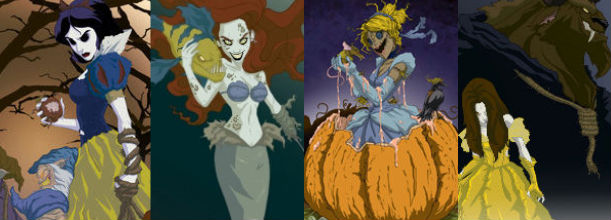Disney in the Dock: A quest for the truth

Sorry if you didn’t know about Santa…
But like the peeling sticker on my The Little Mermaid lunchbox, faith in Disney must inevitably fade over time. In fact, there are plenty of grown-up kids who are so disgruntled to lose their faith they’ve gone alll-out for evil Disney. In a transition as traumatic as discovering Father Christmas doesn’t exist, every child must come to terms with one harrowing fact: Disney films are full of crap. Being a good person doesn’t mean you get to be beautiful, a handsome prince is never the answer to life’s woes and a death will come sooner than that Fairy Godmother you’d been counting on.
Disney Dangers
While cigarettes come with warnings, and junk food comes with nutritional information, Disney films contain no long term warnings about possible side effects and over the can occur later in life. So what can you expect from an overindulgence in Disney? Impossibly high standards when relating to the opposite sex, the feeling that being beautiful makes you more important, the unshakeable belief that the world revolves around you and faith that life will somehow magically work out with little or no effort on your part. That’s right folks, you can expect to turn into Jordan.
Something must be done!
So before the world gains any more inflatable-chested egomaniacs, I propose action. It is time to put Disney films on trial for their crimes against truth and put forward the changes that need to be made before they can re-enter the public realm.
Cinderella
Accused of
: Promoting the idea that beauty equals virtue and that ugliness is something that only happens to the deserving, suggesting that by simply being nice and wishing really hard, you’ll get everything you’ve ever dreamed of.
The prettiest girl in my school was called Tina. She liked Benson and Hedges and clammy sojourns behind the bike sheds with the Prince Charming of the week. She did not count among her friends talking rodents or anyone with a bigger cup size than her. Cinderella, she wasn’t. Not that she was aware of her faults – she was beautiful and that means, according to Disney at least, she was perfect in every other way. Disney wants us to laugh at the ungainly ugly sisters who, unlike Cinderella, at least show signs of life. We are also expected to sneer at the Stepmother who wants the best for her children. Hear that girls? Passion and ambition = badness! Why not just clean the floor and wait to be saved instead? Not only is Cinderella the very definition of bland, she lets everyone walk all over her, never chases her dreams and yet she still gets everything she wants. Why? Because she’s pretty. The end.
Changes
: Cinderella does as she’s told and performs all her domestic chores to perfection…until she dies suddenly from an undiagnosed heart condition. Shame. The ugly sisters go to the ball but the Prince doesn’t look at them twice. In reaction to being snubbed by all, the ugly sisters undergo a radical makeover in an attempt to make the most of what little they have. A makeover duo is born akin to Trinny and Susannah – though perhaps not quite that ugly.
The Little Mermaid
Accused of
: Implying that a woman needs to change herself to bag her man and that emotionally blackmailing daddy is the answer to all a girls problems.
Disney has had its heroines stay quiet, stay pretty and even stay asleep to get their man. But never before had it suggest self mutilation until The Little Mermaid splashed onto our screens in the nineties. Rather than showing Prince Eric her true from (because what man would want to know the real you, ladies?) She transforms herself to try and make herself more alluring. That’s right – if you aren’t perfect for the object of you affections then just change. When your 15 year old daughter starts pestering you for a boob job, you’ll know who to thank.
Changes
: Ariel wants to be a human, but can’t – there’s no such thing as magic, stupid. She asks daddy to pay for some experimental plastic surgery. He grudgingly agrees. She dies on the operating table. Everyone has sushi for dinner.
Beauty and the Beast
Accused of
: Encouraging spousal abuse, dressing up Stockholm Syndrome as love, deluding the entire female gender into believing they can turn their beastly man into a dream prince.
A woman is emotionally and mentally tortured into falling in love with her captor. No, I’m not talking about one of Josef Fritzl’s victims, but rather Belle from Beauty and the Beast. We are told it’s OK that Beast is a grumpy, verbally aggressive douchebag, with a penchant for locking people up because underneath it all, he’s good. Funny – isn’t that what battered wives say after their latest black eye? Isn’t that what all women say about the good-for-nothing partners that they take on, believing they could change them? In Beast, Disney presents us with a sociopath as a romantic hero, who we’re meant to stomach because he’s not as bad as Gaston and oh look! Talking tableware!
Changes
: Belle stands up to the Beast, hitting him over the head with a candlestick (the non-talking variety, of course – none of that nonsense, thank you). She stands trial for manslaughter, but gets acquitted of all charges. Belle sets up a charity for battered and abused women. A book deal ensues and a TV movie is made – Belle is played by Anne Hathaway. The Beast is played by Gaston who, inspired by Belle’s courage, comes out of the closet to the relief of straight women and gay men alike.
Finding Nemo
Accused of
: Dismissing the notion of stranger danger, perpetuating the idea that love solves everything, giving the impression that the world is a kind, forgiving place full of wonderful characters, putting me off my fish and chips.
Lost your son? Don’t worry, with the power of love – and a mentally ill sidekick – you will find him. And even if you don’t straight away, there’s nothing to fear – baddies have big ol’ nasty teeth and make no secret of their intentions. Your little darling will know to steer well clear of them until you find him again. In one of Disney’s most painfully naïve films to date, the message to the kids appears to be trust everyone, because world is a safe place. Take sweets from the man in the trenchcoat who keeps waiting by the school gates, and get into that stranger’s car – he only wants to give you a lift home.
Changes:
After Nemo is taken, a media circus descends around his Father, Marlon. Unable to take the pressure, Marlon descends into a downward spiral of drink, drugs and depression. Meanwhile, Nemo is finding it hard in The Big House (i.e. the fish tank). There are fishy freaks everywhere just waiting to catch him off guard – preferably bent over. He knows he’ll need to toughen up to survive. He doesn’t toughen up. He doesn’t survive. As his body floats to the top of the tank, he curses his careless father for neglecting him. He dies a broken fish.
The prosecution rests…
So there you have it – my case for a realistic Disney – or at least one that prepares kids more adequately for real life. Perhaps you could do your bit too – steal their sweets, kill their beloved pets in front of them – you know, generally get the little tykes used to life’s disappointments….
…Ok, ok, I give. I know life is hard enough without taking away the dubious magic of Uncle Walt. Disney, whether we like it or not – is an institution. A very mental institution at times, but one that can actually manage to shut a 6 year old up for more than five minutes. Besides, there is no denying that Disney is improving – films like Toy Story and Monsters Inc, don’t rely on magic to save the day, but rather the characters have to solve their own problems. Even Disney’s return to fairyland in Tangled and the Princess and the Frog showed a greater emphasis than ever before on the importance of working hard to get what you want. For this clear intention to reform, I think Disney should be let off with a warning this time. And as for the parents of any precocious, Disney-infected child – start with the hamster. They won’t miss the hamster, really. I promise.











Recent Comments